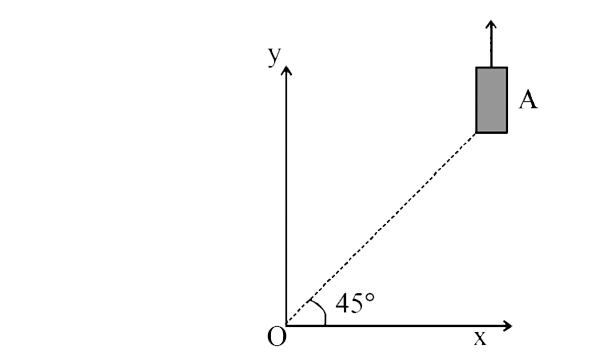Prove that the pair of lines joining the origin to the intersection of the curve x2a2+y2b2=1by
the line lx+my+n=0 are coincident, if a a2l2+b2m2=n2
The correct Answer is:⇒a2l2+b2m2=n2
To prove that the pair of lines joining the origin to the intersection of the curve x2a2+y2b2=1 and the line lx+my+n=0 are coincident if a2l2+b2m2=n2, we will follow these steps:
Step 1: Write the equations
We have the equation of the ellipse:
x2a2+y2b2=1
and the equation of the line:
lx+my+n=0
Step 2: Homogenize the equations
To find the intersection points, we can homogenize the line equation. We can rewrite n as:
n=−lx−my
Substituting this into the ellipse equation gives:
x2a2+y2b2=1⟹x2a2+y2b2=−lx+myn
Step 3: Substitute and simplify
We can multiply through by n2 to eliminate the fraction:
n2(x2a2+y2b2)=−(lx+my)2
This leads to:
n2x2a2+n2y2b2+(lx+my)2=0
Step 4: Expand and rearrange
Expanding (lx+my)2 gives:
l2x2+2lmyx+m2y2
So we have:
n2x2a2+n2y2b2+l2x2+2lmyx+m2y2=0
Rearranging terms:
(n2a2+l2)x2+(n2b2+m2)y2+2lmyx=0
Step 5: Identify coefficients
Let:
A=n2a2+l2,B=n2b2+m2,C=2lm
Step 6: Condition for coincident lines
The lines are coincident if the determinant of the coefficients is zero:
AB−C2=0
Substituting the values gives:
(n2a2+l2)(n2b2+m2)−(2lm)2=0
Step 7: Simplify the determinant condition
Expanding the left-hand side:
n4a2b2+n2l2b2+n2m2a2+l2m2−4l2m2=0
This simplifies to:
n4a2b2+n2l2b2+n2m2a2−3l2m2=0
Step 8: Rearranging to find the condition
Multiplying through by a2b2 gives:
n4+n2l2a2+n2m2b2−3l2m2a2b2=0
This leads to the condition:
a2l2+b2m2=n2
Conclusion
Thus, we have shown that the pair of lines joining the origin to the intersection of the given curve and line are coincident if a2l2+b2m2=n2.
We have the equation of the ellipse:
x2a2+y2b2=1
and the equation of the line:
lx+my+n=0
To find the intersection points, we can homogenize the line equation. We can rewrite n as:
n=−lx−my
Substituting this into the ellipse equation gives:
x2a2+y2b2=1⟹x2a2+y2b2=−lx+myn
We can multiply through by n2 to eliminate the fraction:
n2(x2a2+y2b2)=−(lx+my)2
This leads to:
n2x2a2+n2y2b2+(lx+my)2=0
Expanding (lx+my)2 gives:
l2x2+2lmyx+m2y2
So we have:
n2x2a2+n2y2b2+l2x2+2lmyx+m2y2=0
Rearranging terms:
(n2a2+l2)x2+(n2b2+m2)y2+2lmyx=0
Let:
A=n2a2+l2,B=n2b2+m2,C=2lm
The lines are coincident if the determinant of the coefficients is zero:
AB−C2=0
Substituting the values gives:
(n2a2+l2)(n2b2+m2)−(2lm)2=0
Expanding the left-hand side:
n4a2b2+n2l2b2+n2m2a2+l2m2−4l2m2=0
This simplifies to:
n4a2b2+n2l2b2+n2m2a2−3l2m2=0
Multiplying through by a2b2 gives:
n4+n2l2a2+n2m2b2−3l2m2a2b2=0
This leads to the condition:
a2l2+b2m2=n2
Thus, we have shown that the pair of lines joining the origin to the intersection of the given curve and line are coincident if a2l2+b2m2=n2.
Topper's Solved these Questions
- PAIR OF STRAIGHT LINES BOOK - ARIHANT MATHS ENGLISHCHAPTER - PAIR OF STRAIGHT LINES EXERCISE - Exercise For Session 1
9 Videos
- PAIR OF STRAIGHT LINES BOOK - ARIHANT MATHS ENGLISHCHAPTER - PAIR OF STRAIGHT LINES EXERCISE - Exercise For Session 2
10 Videos
- MONOTONICITY MAXIMA AND MINIMABOOK - ARIHANT MATHS ENGLISHCHAPTER - MONOTONICITY MAXIMA AND MINIMAEXERCISE - Exercise (Questions Asked In Previous 13 Years Exam)
29 Videos
- PARABOLABOOK - ARIHANT MATHS ENGLISHCHAPTER - PARABOLAEXERCISE - Exercise (Questions Asked In Previous 13 Years Exam)
36 Videos
Similar Questions
The equation of the line joining the origin to the point of intersection of the lines 2x2+xy−y2+5x−y+2=0 is
View SolutionIf the lines joining the origin to the points of intersection of the line y=mx+2 and the curve x2+y2=1 are at right-angles, then
View SolutionIf the lines joining the origin to the intersection of the line y=nx+2 and the curve x2+y2=1 are at right angles, then the value of n2 is
View SolutionThe lines joining the origin to the points of intersection of the line 3x-2y -1 and the curve 3x2+5xy−3y2+2x+3y=0, are
View SolutionThe equation of pair of lines joining origin to the points of intersection of x2+y2=9 and x+y=3
View SolutionOn a frictionless horizontal surface , assumed to be the x−y plane , a small trolley A is moving along a straight line parallel to the y−axis ( see figure) with a constant velocity of (√3−1)m/s . At a particular instant , when the line OA makes an angle of 45(∘) with the x− axis , a ball is thrown along the surface from the origin O. Its velocity makes an angle ϕ with the x− axis and it hits the trolley .
(a) The motion of the ball is observed from the frame of the trolley . Calculate the angle θ made by the velocity vector of the ball with the x−axis in this frame .
(b) Find the speed of the ball with respect to the surface , if ϕ=(4θ)/(3).

View SolutionFind the equation of line joining origin to the point of intersection of the pair of lines 3x+y=10 and x−y=2.
View SolutionProve that the pair of straight lines joining the origin to the points of intersection of the circles x2+y2=a and x2+y2+2(gx+fy)=0 is a′(x2+y2)−4(gx+fy)2=0
View SolutionFind the equation to the pair of straight lines joining the origin to the intersections of the straight line y=mx+c and the curve x2+y2=a2 . Prove that they are at right angles if 2c2=a2(1+m2).
View SolutionThe angle between the lines joining the origin to the points of intersection of the line √3x+y=2 and the curve y2−x2=4 is
View Solution
